Interrupted Lives: Welfare Considerations in Wildlife Rehabilitation
Abstract
Simple Summary
Abstract
1. Introduction
2. Wildlife Rehabilitation
2.1. Federally Regulated Wildlife Rehabilitation
2.1.1. Migratory Bird Rehabilitation
2.1.2. Sea Turtle Rehabilitation
2.1.3. Marine Mammal Rehabilitation
2.2. State Regulated Wildlife Rehabilitation
Terrestrial Wildlife Rehabilitation
3. Standards of Care in Wildlife Rehabilitation
3.1. Standards of Care in Migratory Bird Rehabilitation
3.2. Standards of Care in Sea Turtle Rehabilitation
3.3. Standards of Care in Marine Mammal Rehabilitation
3.4. Standards of Care in Terrestrial Wildlife Rehabilitation
4. Welfare Considerations during Wildlife Rehabilitation
4.1. Migratory Bird Welfare
4.1.1. Euthanasia of Migratory Birds
4.1.2. Release of Migratory Birds to the Wild
Post-Release Monitoring of Migratory Birds
4.1.3. Captive Placement of Migratory Birds
4.2. Sea Turtle Welfare
4.2.1. Euthanasia of Sea Turtles
4.2.2. Release of Sea Turtles to the Wild
Post-Release Monitoring of Sea Turtles
4.2.3. Captive Placement of Sea Turtles
4.3. Marine Mammal Welfare
4.3.1. Euthanasia of Marine Mammals
4.3.2. Release of Marine Mammals to the Wild
Post-Release Monitoring of Marine Mammals
4.3.3. Captive Placement of Marine Mammals
4.4. Terrestrial Animal Welfare
4.4.1. Euthanasia of Terrestrial Wildlife
4.4.2. Release of Terrestrial Wildlife to the Wild
Post-Release Monitoring of Terrestrial Wildlife
4.4.3. Captive Placement of Terrestrial Wildlife
5. Conclusions
- Preventing Anthropogenic Causes of Admission. Increasing numbers of animals are being admitted due to anthropogenic causes related to human activities [3,116]. Examining the reasons of wildlife admission provides an opportunity to work upstream to develop mitigation strategies. Preventing the need for rehabilitative care is the best way to improve the welfare of wildlife.
- Providing Resources and Support for Rehabilitation. In the US, wildlife rehabilitation is largely paid for by private individuals and donations. The adoption of established best practices may be limited by physical and/or financial resources. Having public funding at the federal, state, or county level specifically directed to wildlife rehabilitation would allow for improved care and outcomes of wild animals. Although urban wildlife management is a growing field within state fish and game departments, a dedicated revenue stream for wildlife rehabilitation has yet to be identified [171,175].
- Continued Development of Evidence-based Wildlife Rehabilitation Methods and Welfare Measures. The advent of electronic database programs specific to wildlife rehabilitation [176,177,178,179] has resulted in greater access to large data sets. These data provide vital information for making better care choices for individuals and facilities. By combining these data in collaboration with other institutions and data from post-release monitoring, wildlife rehabilitation professionals can develop protocols with the highest likelihood of successful outcomes, and concurrently improve the welfare of all animals under care [2,25,31,118,174,180].
- Greater Engagement of the Veterinary Profession. Wildlife welfare would benefit greatly from increased veterinary involvement in wildlife rehabilitation. All animals need a rapid and thorough assessment within the first few hours of presentation. Only veterinarians can provide diagnostic testing, surgical care, access to analgesics, the most humane euthanasia methods, and recommend captive placement. There is training available for veterinarians and veterinary students [181,182].
- Harmonization of Regulatory Oversight with Standards of Care, Training, and Accountability. Federal and state regulatory policies should be reviewed and updated on a regular schedule. These reviews should incorporate the most recent evidence-based science and enhance standards of rehabilitative care, training, and accountability to ensure optimal welfare for wildlife. Increasing harmonization of wildlife rehabilitation policies within federal programs, between state programs, and between federal and state programs would also improve wildlife welfare by ensuring prompt care and allowing for more data aggregation. Ongoing collaborations between federal and state level regulators, wildlife rehabilitators, and clinical wildlife veterinarians help prepare for and mitigate the challenges ahead for wildlife and rehabilitation.
- Increasing Public Education. Interactions between urban wildlife and the public are increasing. Stimulating interest in local wildlife to prevent conflict, countering misinformation about animal behavior, and providing tools for successful coexistence with wildlife is another strategy to reduce the number of animals in need of rehabilitative care [30,183,184].
Author Contributions
Funding
Institutional Review Board Statement
Informed Consent Statement
Data Availability Statement
Acknowledgments
Conflicts of Interest
References
- Clark, E.E.; (President and Founder of the Wildlife Center of Virginia, Waynesboro, VA, USA). Personal communication, 2010.
- Cope, H.R.; McArthur, C.; Dickman, C.R.; Newsome, T.M.; Gray, R.; Herbert, C.A. A Systematic Review of Factors Affecting Wildlife Survival during Rehabilitation and Release. PLoS ONE 2022, 17, e0265514. [Google Scholar] [CrossRef]
- Hanson, M.; Hollingshead, N.; Schuler, K.; Siemer, W.F.; Martin, P.; Bunting, E.M. Species, Causes, and Outcomes of Wildlife Rehabilitation in New York State. PLoS ONE 2021, 16, e0257675. [Google Scholar] [CrossRef]
- Cox, S. Reasons Why Animals Are Admitted to Wildlife Rehabilitation Centers in Canada. Wildl. Rehabil. Bull. 2022, 39, 1–8. [Google Scholar] [CrossRef]
- King, M.; Giacinti, J.; Dubois, S.; Lair, S.; Parmley, E.J.; Jardine, C.M. Using Wildlife Rehabilitation and Postmortem Data to Identify Key Causes of Morbidity and Mortality Impacting the Health and Welfare of Free-Living Wild Animals in Canada. J. Wildl. Dis. 2023, 59, 93–108. [Google Scholar] [CrossRef]
- Burton, D.L.; Doblar, K.A. Morbidity and Mortality of Urban Wildlife in the Midwestern United States. In Proceedings of the Proceedings 4th Annual International Urban Wildlife Symposium; University of Arizona: Tucson, AZ, USA, 2004; pp. 171–181. [Google Scholar]
- Way Rose, B.M.; Allender, M.C. Health Assessment of Wild Eastern Box Turtles (Terrapene Carolina Carolina) in East Tennessee. J. Herpetol. Med. Surg. 2011, 21, 107. [Google Scholar] [CrossRef]
- Wallace, B.P.; Kot, C.Y.; DiMatteo, A.D.; Lee, T.; Crowder, L.B.; Lewison, R.L. Impacts of Fisheries Bycatch on Marine Turtle Populations Worldwide: Toward Conservation and Research Priorities. Ecosphere 2013, 4, art40. [Google Scholar] [CrossRef]
- Foley, A.M.; Stacy, B.A.; Hardy, R.F.; Shea, C.P.; Minch, K.E.; Schroeder, B.A. Characterizing Watercraft-related Mortality of Sea Turtles in Florida. J. Wildl. Manag. 2019, 83, 1057–1072. [Google Scholar] [CrossRef]
- Bogomolni, A.; Pugliares, K.; Sharp, S.; Patchett, K.; Harry, C.; LaRocque, J.; Touhey, K.; Moore, M. Mortality Trends of Stranded Marine Mammals on Cape Cod and Southeastern Massachusetts, USA, 2000 to 2006. Dis. Aquat. Organ. 2010, 88, 143–155. [Google Scholar] [CrossRef]
- Barcenas-De la Cruz, D.; DeRango, E.; Johnson, S.P.; Simeone, C.A. Evidence of Anthropogenic Trauma in Marine Mammals Stranded along the Central California Coast, 2003–2015. Mar. Mammal Sci. 2018, 34, 330–346. [Google Scholar] [CrossRef]
- NWRA History. Available online: https://www.nwrawildlife.org/page/NWRAHistory (accessed on 13 March 2023).
- Buhl, G.; Willette, M.; Ponder, J. Wildlife Rehabilitation Characterization for Opportunities in Increasing Animal Welfare; The Raptor Center, University of Minnesota: Minneapolis, MN, USA, 2016. [Google Scholar]
- Kirkwood, J.K. Wild Animal Welfare. Anim. Welf. 2013, 22, 147–148. [Google Scholar] [CrossRef]
- Thulin, C.-G.; Röcklinsberg, H. Ethical Considerations for Wildlife Reintroductions and Rewilding. Front. Vet. Sci. 2020, 7, 163. [Google Scholar] [CrossRef]
- Principles of Veterinary Medical Ethics of the AVMA. Available online: https://www.avma.org/resources-tools/avma-policies/principles-veterinary-medical-ethics-avma (accessed on 17 April 2023).
- Animal Welfare—WOAH. Available online: https://www.woah.org/en/what-we-do/animal-health-and-welfare/animal-welfare/ (accessed on 13 March 2023).
- Moberg, G.P.; Mench, J.A. (Eds.) The Biology of Animal Stress: Basic Principles and Implications for Animal Welfare; CABI Publishing: Wallingford, UK, 2000; pp. 1–377. [Google Scholar]
- Schott, R. Can Wildlife Rehabilitators Really ‘Do No Harm’? J. Wildl. Rehabil. 2015, 35, 4–6. [Google Scholar]
- Teixeira, C.P.; de Azevedo, C.S.; Mendl, M.; Cipreste, C.F.; Young, R.J. Revisiting Translocation and Reintroduction Programmes: The Importance of Considering Stress. Anim. Behav. 2007, 73, 1–13. [Google Scholar] [CrossRef]
- Selye, H.A. Syndrome Produced by Diverse Nocuous Agents. Nature 1936, 138, 32. [Google Scholar] [CrossRef]
- Selye, H. Stress and the General Adaptation Syndrome. BMJ 1950, 1, 1383–1392. [Google Scholar] [CrossRef]
- Karaer, M.C.; Čebulj-Kadunc, N.; Snoj, T. Stress in Wildlife: Comparison of the Stress Response among Domestic, Captive, and Free-Ranging Animals. Front. Vet. Sci. 2023, 10, 1167016. [Google Scholar] [CrossRef]
- Lu, S.; Wei, F.; Li, G. The Evolution of the Concept of Stress and the Framework of the Stress System. Cell Stress 2021, 5, 76–85. [Google Scholar] [CrossRef]
- Grogan, A.; Kelly, A.A. Review of RSPCA Research into Wildlife Rehabilitation. Vet. Rec. 2013, 172, 211. [Google Scholar] [CrossRef]
- Haas, K.B. A History of Wildlife Conservation and Rehabilitation, Part I. Wildl. Rehabil. Today 1998, 9, 26–31. [Google Scholar]
- Haas, K.B. A History of Wildlife Conservation and Rehabilitation, Part 2. Wildl. Rehabil. Today 1998, 10, 31–38. [Google Scholar]
- Thrune, E. The First Twenty Years of Wildife Rehabilitation. Proc. National Wildl. Rehabil. Symp. 2002, 20, 141–150. [Google Scholar]
- IWRC. Our History. Available online: https://theiwrc.org/about-us/history/ (accessed on 13 March 2023).
- Dubois, S.A. Survey of Wildlife Rehabilitation Goals, Impediments, Issues, and Success in British Columbia, Canada. Ph.D. Thesis, University of British Columbia, Vancouver, BC, Canada, 2003. [Google Scholar] [CrossRef]
- Mullineaux, E. Veterinary Treatment and Rehabilitation of Indigenous Wildlife. J. Small Anim. Pract. 2014, 55, 293–300. [Google Scholar] [CrossRef] [PubMed]
- Sleeman, J.M.; Clark, E.E. Clinical Wildlife Medicine: A New Paradigm for a New Century. J. Avian Med. Surg. 2003, 17, 33–37. [Google Scholar] [CrossRef]
- Rabinowitz, P.M.; Gordon, Z.; Holmes, R.; Taylor, B.; Wilcox, M.; Chudnov, D.; Nadkarni, P.; Dein, F.J. Animals as Sentinels of Human Environmental Health Hazards: An Evidence-Based Analysis. EcoHealth 2005, 2, 26–37. [Google Scholar] [CrossRef]
- Duncan, C.; Backus, L.; Lynn, T.; Powers, B.; Salman, M. Passive, Opportunistic Wildlife Disease Surveillance in the Rocky Mountain Region, USA. Transbound. Emerg. Dis. 2008, 55, 308–314. [Google Scholar] [CrossRef]
- Stephen, C.; Duncan, C. Can Wildlife Surveillance Contribute to Public Health Preparedness for Climate Change? A Canadian Perspective. Clim. Chang. 2017, 141, 259–271. [Google Scholar] [CrossRef]
- Hernandez, S.M.; Barron, H.W.; Miller, E.A.; Aguilar, R.F.; Yabsley, M.J. (Eds.) Medical Management of Wildlife Species: A Guide for Practitioners, 1st ed.; Wiley: Hobboken, NJ, USA, 2019; pp. 1–496. ISBN 978-1-119-03658-6. [Google Scholar]
- Tribe, A.; Orr, B. Wildlife Rehabilitation Practices in Australia. In Current Therapy in Medicine of Australian Mammals; CSIRO Publishing: Clayton, Australia, 2019; pp. 51–62. [Google Scholar]
- Chaves, A.; Montecino-Latorre, D.; Alcázar, P.; Suzán, G. Wildlife Rehabilitation Centers as a Potential Source of Transmission of SARS-CoV-2 into Native Wildlife of Latin America. Biotropica 2021, 53, 987–993. [Google Scholar] [CrossRef]
- Monadjem, A.; Wolter, K.; Neser, W.; Kane, A. Effect of Rehabilitation on Survival Rates of Endangered Cape Vultures: Effect of Rehabilitation on Survival of Cape Vultures. Anim. Conserv. 2014, 17, 52–60. [Google Scholar] [CrossRef]
- The IUCN Red List of Threatened Species. Available online: https://www.iucnredlist.org/en (accessed on 16 March 2023).
- Bacon, H. Wildlife Utilization and One Welfare. In One Welfare in Practice: The Role of the Veterinarian; Stephens, T., Ed.; CRC One Health One Welfare; CRC Press: Boca Raton, FL, USA, 2022; pp. 121–138. ISBN 978-1-00-321833-3. [Google Scholar]
- Standards of Excellence for Animal Sanctuaries—GFAS. Glob. Fed. Anim. Sanctuaries. Available online: https://sanctuaryfederation.org/accreditation/standards/ (accessed on 18 March 2023).
- WAZA. Animal Welfare Strategies. Available online: https://www.waza.org/ (accessed on 18 March 2023).
- Miller, E.; Schlieps, J. Standards for Wildlife Rehabilitation; National Wildlife Rehabilitators Association: Bloomington, MN, USA, 2021. [Google Scholar]
- Johnson, A. Overview of Wildlife Rehabilitation Laws; Animal Legal & Historical Center. Available online: https://www.animallaw.info/article/overview-wildlife-rehabilitation-laws (accessed on 13 March 2023).
- National Agricultural Library. Animal Welfare Act. Available online: https://www.nal.usda.gov/animal-health-and-welfare/animal-welfare-act (accessed on 18 April 2023).
- McRuer, D. New Tools and Templates to Revolutionize Data Collection and Management in Wildlife Care Facilities. In Proceedings of the Maryland Wildlife Rehabilitation Association Meeting, Patuxent Wildlife Visitors Center, Laurel, MD, USA, 29–30 October 2011. [Google Scholar]
- Willette, M. Descriptive Review of MBTA Wildlife Rehabilitation Annual Reports (Region 3, 2011); The Raptor Center, University of Minnesota: St. Paul, MN, USA, 2014. [Google Scholar]
- Thrune, E. National Wildlife Rehabilitators Association 2008 Member Survey Report Parts 1 through 4; National Wildlife Rehabilitators Association: St. Cloud, MN, USA, 2008. [Google Scholar]
- Fish & Wildlife Service. Migratory Bird Treaty Act of 1918. Available online: https://www.fws.gov/law/migratory-bird-treaty-act-1918 (accessed on 13 March 2023).
- U.S. Fish & Wildlife Service. Bald and Golden Eagle Protection Act. Available online: https://www.fws.gov/law/bald-and-golden-eagle-protection-act (accessed on 14 March 2023).
- 50 CFR 21.76; Rehabilitation Permits. Available online: https://www.ecfr.gov/current/title-50/chapter-I/subchapter-B/part-21/subpart-C/section-21.76 (accessed on 13 March 2023).
- 2003 Federal Register, 68 FR 61123; Centralized Library, U.S. Fish and Wildlife Service—FR Doc 03-26823. Available online: https://www.fws.gov/policy/library/2003/03-26823.html (accessed on 13 March 2023).
- Miller, E.A. (Ed.) Minimum Standards for Wildlife Rehabilitation, 3rd ed.; International Wildlife Rehabilitation Council: Suisun, CA, USA; National Wildlife Rehabilitators Association: St. Cloud, MN, USA, 2000; ISBN 978-1-931439-00-8. [Google Scholar]
- Migratory Bird Rehabilitation—Annual Report; U.S. Fish and Wildlife Service: Washington, DC, USA, 2020. Available online: https://www.fws.gov/sites/default/files/documents/3-202-4Rpt.pdf (accessed on 18 March 2023).
- Wallace, B.P.; DiMatteo, A.D.; Bolten, A.B.; Chaloupka, M.Y.; Hutchinson, B.J.; Abreu-Grobois, F.A.; Mortimer, J.A.; Seminoff, J.A.; Amorocho, D.; Bjorndal, K.A.; et al. Global Conservation Priorities for Marine Turtles. PLoS ONE 2011, 6, e24510. [Google Scholar] [CrossRef]
- Wallace, B.; Brosnan, T.; McLamb, D.; Rowles, T.; Ruder, E.; Schroeder, B.; Schwacke, L.; Stacy, B.; Sullivan, L.; Takeshita, R.; et al. Effects of the Deepwater Horizon Oil Spill on Protected Marine Species. Endanger. Species Res. 2017, 33, 1–7. [Google Scholar] [CrossRef]
- García-Párraga, D.; Crespo-Picazo, J.; de Quirós, Y.; Cervera, V.; Martí-Bonmati, L.; Díaz-Delgado, J.; Arbelo, M.; Moore, M.; Jepson, P.; Fernández, A. Decompression Sickness (‘the Bends’) in Sea Turtles. Dis. Aquat. Organ. 2014, 111, 191–205. [Google Scholar] [CrossRef] [PubMed]
- Roberts, K.; Collins, J.; Paxton, C.H.; Hardy, R.; Downs, J. Weather Patterns Associated with Green Turtle Hypothermic Stunning Events in St. Joseph Bay and Mosquito Lagoon, Florida. Phys. Geogr. 2014, 35, 134–150. [Google Scholar] [CrossRef]
- Jones, K.; Ariel, E.; Burgess, G.; Read, M.A. Review of Fibropapillomatosis in Green Turtles (Chelonia mydas). Vet. J. 2016, 212, 48–57. [Google Scholar] [CrossRef] [PubMed]
- Stacy, N.; Field, C.; Staggs, L.; MacLean, R.; Stacy, B.; Keene, J.; Cacela, D.; Pelton, C.; Cray, C.; Kelley, M.; et al. Clinicopathological Findings in Sea Turtles Assessed during the Deepwater Horizon Oil Spill Response. Endanger. Species Res. 2017, 33, 25–37. [Google Scholar] [CrossRef]
- Griffin, L.P.; Griffin, C.R.; Finn, J.T.; Prescott, R.L.; Faherty, M.; Still, B.M.; Danylchuk, A.J. Warming Seas Increase Cold-Stunning Events for Kemp’s Ridley Sea Turtles in the Northwest Atlantic. PLoS ONE 2019, 14, e0211503. [Google Scholar] [CrossRef]
- 50 CFR Part 222; General Endangered and Threatened Marine Species. Available online: https://www.ecfr.gov/current/title-50/chapter-II/subchapter-C/part-222 (accessed on 18 April 2023).
- 50 CFR Part 223; Threatened Marine and Anadromous Species. Available online: https://www.ecfr.gov/current/title-50/chapter-II/subchapter-C/part-223 (accessed on 18 April 2023).
- U.S. Fish and Wildlife Service. Standard Conditions for Care and Maintenance of Captive Sea Turtles 2019. Available online: https://www.fws.gov/sites/default/files/documents/seaturtle-standard-conditions-for-care-2019.pdf (accessed on 8 April 2023).
- NOAA Fisheries. Frequent Questions: Northern Gulf of Mexico Sea Turtle Strandings. Available online: https://www.fisheries.noaa.gov/southeast/marine-life-distress/frequent-questions-northern-gulf-mexico-sea-turtle-strandings (accessed on 13 March 2023).
- Wyneken, J.; Mader, D.; Weber, E.; Merigo, C. Medical Care of Sea Turtles. In Reptile Medicine and Surgery; Mader, D., Ed.; Elsevier: St. Louis, MO, USA, 2006; pp. 972–1007. [Google Scholar]
- Flint, J.; Flint, M.; Limpus, C.J.; Mills, P. Status of Marine Turtle Rehabilitation in Queensland. PeerJ 2017, 5, e3132. [Google Scholar] [CrossRef]
- Stevens, B. Assessment of Sea Turtle Rehabilitation in North Carolina; Duke University: Durham, NC, USA, 2019. [Google Scholar]
- Roldi, C.; Freggi, D. Determination of the Factors that Might Have Influenced the Rehabilitation of Caretta caretta in the Lampedusa Sea Turtle Rescue Center between 2001–2016. Nat. Croat. 2020, 29, 59–66. [Google Scholar]
- Gallini, S.H.; Di Girolamo, N.; Hann, E.; Paluch, H.; DiGeronimo, P.M. Outcomes of 4,819 Cases of Marine Animals Presented to a Wildlife Rehabilitation Center in New Jersey, USA (1976–2016). Sci. Rep. 2021, 11, 2182. [Google Scholar] [CrossRef]
- Wood, L. Managing Long-Term Wellness in Captive Sea Turtles. Anim. Welf. 2022, 31, 423–432. [Google Scholar] [CrossRef]
- Baker, L.; Edwards, W.; Pike, D. Sea Turtle Rehabilitation Success Increases with Body Size and Differs among Species. Endanger. Species Res. 2015, 29, 13–21. [Google Scholar] [CrossRef]
- Innis, C.J.; Finn, S.; Kennedy, A.; Burgess, E.; Norton, T.; Manire, C.A.; Harms, C.A. Summary of Sea Turtles Released from Rescue and Rehabilitation Programs in the United States, with Observations on Re-Encounters. Chelonian Conserv. Biol. 2019, 18, 3. [Google Scholar] [CrossRef]
- NOAA Fisheries. Marine Mammal Protection Act. Available online: https://www.fisheries.noaa.gov/national/marine-mammal-protection/marine-mammal-protection-act (accessed on 18 April 2023).
- Threatened and Endangered Species. Available online: https://wildlife.ca.gov/Conservation/CESA (accessed on 18 April 2023).
- 68C-22: The Florida Manatee Sanctuary Act. Available online: https://www.flrules.org/gateway/ChapterHome.asp?Chapter=68C-22 (accessed on 18 April 2023).
- Onens, P. 2019 Report of Marine Mammal Strandings in the United States: National Overview; NOAA: Washington, DC, USA, 2023. [Google Scholar] [CrossRef]
- Wildlife Educator’s Code of Ethics. Available online: https://www.nwrawildlife.org/page/Code_of_Ethics_Ed (accessed on 17 April 2023).
- Wildlife Rehabilitator’s Code of Ethics. Available online: https://www.nwrawildlife.org/page/Code_of_Ethics_Rehab (accessed on 17 April 2023).
- Rao, A.K.; Briggs, D.; Moore, S.M.; Whitehill, F.; Campos-Outcalt, D.; Morgan, R.L.; Wallace, R.M.; Romero, J.R.; Bahta, L.; Frey, S.E.; et al. Use of a Modified Preexposure Prophylaxis Vaccination Schedule to Prevent Human Rabies: Recommendations of the Advisory Committee on Immunization Practices—United States, 2022. MMWR Morb. Mortal. Wkly. Rep. 2022, 71, 619–627. [Google Scholar] [CrossRef] [PubMed]
- Clapham, M.O.; Martin, K.L.; Davis, J.L.; Baynes, R.E.; Lin, Z.; Vickroy, T.W.; Riviere, J.E.; Tell, L. Extralabel Drug Use in Wildlife and Game Animals. J. Am. Vet. Med. Assoc. 2019, 255, 555–568. [Google Scholar] [CrossRef] [PubMed]
- FARAD. Available online: http://www.farad.org/ (accessed on 17 April 2023).
- Scott, D.E. Raptor Medicine, Surgery, and Rehabilitation, 3rd ed.; CABI International: Wallingford, UK, 2020; ISBN 978-1-78924-610-0. [Google Scholar]
- Arent, L.A.; Willette, M.; Buhl, G. Raptors as Victims and Ambassadors: Raptor Rehabilitation, Education, and Outreach. In Urban Raptors; Boal, C., Dykstra, C., Eds.; Island Press: Washington, DC, USA, 2018; pp. 229–245. [Google Scholar]
- Wildlife Rehabilitation. Available online: https://www.paws.org/wildlife/wildlife-rehabilitation/ (accessed on 8 April 2023).
- 50 CFR Part 13; General Permit Procedures. Available online: https://www.ecfr.gov/current/title-50/chapter-I/subchapter-B/part-13?toc=1 (accessed on 18 April 2023).
- 50 CFR Part 21; Migratory Bird Permits. Available online: https://www.ecfr.gov/current/title-50/chapter-I/subchapter-B/part-21 (accessed on 18 April 2023).
- Willette, M. Descriptive Review of MBTA Special Purpose—Possession for Education (Live) Annual Reports (Region 3, 2017); Unpublished Work; The Raptor Center 2018, University of Minnesota: St. Paul, MN, USA, 2018. [Google Scholar]
- Moore, A.; Joosten, S. NWRA Principles of Wildlife Rehabilitation, 2nd ed.; National Wildlife Rehabilitators Association: St. Cloud, MN, USA, 2002. [Google Scholar]
- Association of Zoos & Aquariums, Animal Care Manuals. Available online: https://www.aza.org/animal-care-manuals?locale=en (accessed on 17 April 2023).
- Manire, C.; Norton, T.; Stacy, B.; Norton, T.; Innis, C. (Eds.) Sea Turtle Health and Rehabilitation; J Ross Publishing: Plantation, FL, USA, 2017; pp. 1–1145. [Google Scholar]
- Stacy, N.I.; Innis, C.J.; Hernandez, J.A. Development and Evaluation of Three Mortality Prediction Indices for Cold-Stunned Kemp’s Ridley Sea Turtles (Lepidochelys kempii). Conserv. Physiol. 2013, 1, cot003. [Google Scholar] [CrossRef]
- Stacy, N.I.; Lynch, J.M.; Arendt, M.D.; Avens, L.; Braun McNeill, J.; Cray, C.; Day, R.D.; Harms, C.A.; Lee, A.M.; Peden-Adams, M.M.; et al. Chronic Debilitation in Stranded Loggerhead Sea Turtles (Caretta caretta) in the Southeastern United States: Morphometrics and Clinicopathological Findings. PLoS ONE 2018, 13, e0200355. [Google Scholar] [CrossRef] [PubMed]
- NOAA Fisheries. Marine Mammal Health and Stranding Response Program. Available online: https://www.fisheries.noaa.gov/national/marine-life-distress/marine-mammal-health-and-stranding-response-program (accessed on 18 April 2023).
- Gulland, F.M.D.; Dierauf, L.A.; Whitman, K.L. CRC Handbook of Marine Mammal Medicine, 3rd ed.; CRC Press: Boca Raton, FL, USA, 2018; ISBN 978-1-4987-9687-3. [Google Scholar]
- Miller, R.E.; Lamberski, N.; Calle, P.P. (Eds.) Fowler’s Zoo and Wild Animal Medicine: Current Therapy, 9th ed.; Elsevier: St. Louis, MO, USA, 2019; ISBN 978-0-323-55228-8. [Google Scholar]
- Brambell, F.W.R. Report of the Technical Committee to Enquire into the Welfare of Animals Kept under Intensive Livestock Husbandry Systems; CiNii: London, UK, 1965. [Google Scholar]
- Mellor, D.J.; Reid, C.S.W. Concepts of Animal Well-Being and Predicting the Impact of Procedures on Experimental Animals. In Improving the Well-being of Animals in the Research Environment; Baker, R., Jenkin, G., Mellor, D., Eds.; Australian and New Zealand Council for the Care of Animals in Research and Teaching: Glen Osmond, Australia, 1994; pp. 3–18. [Google Scholar]
- Mellor, D.J.; Beausoleil, N.J.; Littlewood, K.E.; McLean, A.N.; McGreevy, P.D.; Jones, B.; Wilkins, C. The 2020 Five Domains Model: Including Human–Animal Interactions in Assessments of Animal Welfare. Animals 2020, 10, 1870. [Google Scholar] [CrossRef] [PubMed]
- Fraser, D.; Weary, D.M.; Pajor, E.A.; Milligan, B.N. A Scientific Conception of Animal Welfare That Reflects Ethical Concerns. Anim. Welf. 1997, 6, 187–205. [Google Scholar] [CrossRef]
- Vincino, G.; Miller, I.J. From Prevention of Cruelty to Optimizing Welfare: Opportunities to Thrive. In Proceedings of the International Ethological Conference, Cairns, Australia, 9–14 August 2015; Volume 19. [Google Scholar]
- Animal Welfare Committee. Available online: https://www.aza.org/animal_welfare_committee?locale=en (accessed on 13 March 2023).
- Welfare Topics, American College of Animal Welfare. Available online: https://www.acaw.org/content.aspx?page_id=22&club_id=86378&module_id=266467 (accessed on 17 April 2023).
- Animal Welfare: What Is It? AVMA. Available online: https://www.avma.org/resources/animal-health-welfare/animal-welfare-what-it (accessed on 13 March 2023).
- The Five Domains. Available online: https://zooaquarium.org.au/public/Public/Animal-Welfare/The-Five-Domains.aspx (accessed on 17 April 2023).
- Farm Animal Welfare in Great Britain; Farm Animal Welfare Council: London, UK, 2009.
- Joyner, L. Ethical Considerations in Wildlife Medicine. Wildl. Rehabil. Bull. 2022, 39, 36–46. [Google Scholar] [CrossRef]
- Fraser, D. A “Practical” Ethic for Animals. J. Agric. Environ. Ethics 2012, 25, 721–746. [Google Scholar] [CrossRef]
- Fawcett, A.; Mullan, S.; McGreevy, P. Application of Fraser’s “Practical” Ethic in Veterinary Practice, and Its Compatibility with a “One Welfare” Framework. Animals 2018, 8, 109. [Google Scholar] [CrossRef]
- Cook, R.; Karesh, W.B.; Osofsky, S.A. Manhattan Principles. In Proceedings of the Manhattan Principles on “One World, One Health” Symposium Summary, New York, NY, USA, 19 September 2004. [Google Scholar]
- CDC. One Health. Available online: https://www.cdc.gov/onehealth/index.html (accessed on 17 April 2023).
- WOAH. One Health. Available online: https://www.woah.org/en/what-we-do/global-initiatives/one-health/ (accessed on 17 April 2023).
- Colonius, T.J.; Earley, R.W. One Welfare: A Call to Develop a Broader Framework of Thought and Action. J. Am. Vet. Med. Assoc. 2013, 242, 309–310. [Google Scholar] [CrossRef] [PubMed]
- Pinillos, R.G.; Appleby, M.C.; Manteca, X.; Scott-Park, F.; Smith, C.; Velarde, A. One Welfare—A Platform for Improving Human and Animal Welfare. Vet. Rec. 2016, 179, 412–413. [Google Scholar] [CrossRef] [PubMed]
- Schenk, A.N.; Souza, M.J. Major Anthropogenic Causes for and Outcomes of Wild Animal Presentation to a Wildlife Clinic in East Tennessee, USA, 2000–2011. PLoS ONE 2014, 9, e93517. [Google Scholar] [CrossRef] [PubMed]
- Kelly, G.; delBarco-Trillo, J. Importance of Taxonomic Group, Life Stage and Circumstance of Rescue upon Wildlife Rehabilitation in Ontario, Canada. J. Nat. Conserv. 2020, 57, 125897. [Google Scholar] [CrossRef]
- Niswonger, A.E.; Gibson, S.; Young, A.M. Prediction Factors for Release of Wildlife at an American Midwestern Rehabilitation Facility. J. Wildl. Rehabil. 2023, 43, 17–27. [Google Scholar]
- Lacy, K. Selection Process for Non-Releasable Birds: The First Step in Bird Welfare. In Proceedings of the IAATE Conference Proceedings, Atlanta, GA, USA, 22–25 February 2017. [Google Scholar]
- Lacy, K. Compassionate Euthanasia. Available online: https://cascadesraptorcenter.org/wp-content/uploads/2023/01/IAATEWinter2023_CompassionateEuthanasia.pdf (accessed on 17 April 2023).
- Position Statements, The International Association of Avian Trainers and Educators (IAATE). Available online: https://iaate.org/position-statements/ (accessed on 18 April 2023).
- Inzani, H.; Williams, D.L. Comparison of Rehabilitation Rates of Birds of Prey from a Raptor Rehabilitation Centre Ten Years Apart. Int. J. Avian Wildl. Biol. 2018, 3, 447–451. [Google Scholar] [CrossRef]
- Leary, S.; Underwood, W.; Anthony, R.; Cartner, S.; Johnson, C.L.; Patterson-Kane, E. AVMA Guidelines for the Euthanasia of Animals, 2020 ed.; AVMA: Schaumburg, IL, USA, 2020. [Google Scholar]
- Ahlmann-Garcia, A.; (Associate Veterinarian, The Raptor Center, College of Veterinary Medicine, University of Minnesota, St. Paul, MN, USA). Unpublished work. 2021.
- Hepps Keeney, C.; Harrison, T.M. Euthanasia Complications in Non-Domestic Species. J. Zool. Bot. Gard. 2022, 3, 616–623. [Google Scholar] [CrossRef]
- Fox, N. Understanding the Bird of Prey; Hancock House: Surrey, BC, Canada, 1995; ISBN 978-0-88839-317-3. [Google Scholar]
- Goody, A.; Ferris, R.; Gelatos, M.; Yim, C. Background Music to Reduce Startle Response in Wild Avian Species During Rehabilitation. J. Wildl. Rehabil. 2013, 33, 13–18. [Google Scholar]
- Potts, A. Captive Enrichment for Owls (Strigiformes). J. Wildl. Rehabil. 2016, 36, 11–29. [Google Scholar]
- Joys, A.C.; Clark, N.; Clark, J.; Robinson, R. An Investigation of the Effectiveness of Rehabilitation of Birds as Shown by Ringing Recoveries; British Trust for Ornithology: Thetford, UK, 2003. [Google Scholar]
- Fiorello, C.V.; Jodice, P.G.R.; Lamb, J.; Satgé, Y.; Mills, K.; Ziccardi, M. Postrelease Survival of California Brown Pelicans (Pelecanus Occidentalis Californicus) Following Oiling and Rehabilitation after the Refugio Oil Spill. J. Wildl. Dis. 2021, 57, 590–600. [Google Scholar] [CrossRef]
- De La Cruz, S.E.W.; Takekawa, J.Y.; Spragens, K.A.; Yee, J.; Golightly, R.T.; Massey, G.; Henkel, L.A.; Scott Larsen, R.; Ziccardi, M. Post-Release Survival of Surf Scoters Following an Oil Spill: An Experimental Approach to Evaluating Rehabilitation Success. Mar. Pollut. Bull. 2013, 67, 100–106. [Google Scholar] [CrossRef]
- Martell, M.; Goggin, J.; Redig, P.T. Survival and Movements of Released Rehabilitated Bald Eagles. In Proceedings of the Raptor Biomedicine III, Midrand, South Africa, 9–11 August 1998. [Google Scholar]
- Leighton, K.; Chilvers, D.; Charles, A.; Kelly, A. Post-Release Survival of Hand-Reared Tawny Owls (Strix aluco) Based on Radio-Tracking and Leg-Band Return Data. Anim. Welf. 2008, 17, 207–214. [Google Scholar] [CrossRef]
- Vergneau-Grosset, C.; Dubé, C.; Fitzgerald, G.; Lair, S. Characteristics of Antebrachial Fractures Associated with a Successful Outcome among Free-Ranging Birds of Prey that Received Treatment in a Rehabilitation Program. J. Am. Vet. Med. Assoc. 2020, 256, 580–589. [Google Scholar] [CrossRef] [PubMed]
- Sandberg, J.; Van deelen, T.R.; Berres, M.E. Survival of Rehabilitated and Released Red-Tailed Hawks (Buteo jamaicensis). Wildl. Rehabil. Bull. 2022, 38, 28–39. [Google Scholar] [CrossRef]
- Mladonicky, J.; Sirolli, M.; Willette, M.; Ponder, J. Evaluation of Current Scientfiic Literature on the Impact of Wildlife Rehabilitation on Conservation, Documentation of Knowledge Gaps and Identification of Future Opportunities; US Fish and Wildlife Service: Bailey Falls, VA, USA, 2021.
- Fish & Wildlife Service. Permit Types and Forms. Available online: https://www.fws.gov/program/migratory-bird-permit/permit-types-and-forms (accessed on 13 March 2023).
- Standards for Birds Not Bred for Use in Research under the Animal Welfare Act. Available online: https://www.federalregister.gov/documents/2023/02/21/2023-03357/standards-for-birds-not-bred-for-use-in-research-under-the-animal-welfare-act (accessed on 18 April 2023).
- Buhl, G.; Schlieps, J.; Smith, L. Wildlife in Education: A Guide for the Care and Use of Program Animals, 2nd ed.; National Wildlife Rehabilitators Association: St. Cloud, MN, USA, 2018. [Google Scholar]
- Escobedo-Bonilla, C.M.; Quiros-Rojas, N.M.; Rudín-Salazar, E. Rehabilitation of Marine Turtles and Welfare Improvement by Application of Environmental Enrichment Strategies. Animals 2022, 12, 282. [Google Scholar] [CrossRef] [PubMed]
- Hunt, K.E.; Innis, C.; Rolland, R.M. Corticosterone and Thyroxine in Cold-Stunned Kemp’s Ridley Sea Turtles (Lepidochelys kempii). J. Zoo Wildl. Med. 2012, 43, 479–493. [Google Scholar] [CrossRef]
- Aleman, M.; Davis, E.; Williams, D.C.; Madigan, J.E.; Smith, F.; Guedes, A. Electrophysiologic Study of a Method of Euthanasia Using Intrathecal Lidocaine Hydrochloride Administered during Intravenous Anesthesia in Horses. J. Vet. Intern. Med. 2015, 29, 1676–1682. [Google Scholar] [CrossRef]
- Whitmer, E.R.; Trumbull, E.J.; Harris, H.S.; Whoriskey, S.T.; Field, C.L. Use of Potassium Chloride for Low-Residue Euthanasia of Anesthetized California Sea Lions (Zalophus californianus) and Northern Elephant Seals (Mirounga angustirostris) with Life-Threatening Injury or Disease. J. Am. Vet. Med. Assoc. 2021, 259, 197–201. [Google Scholar] [CrossRef]
- Hunt, K.E.; Innis, C.; Merigo, C.; Burgess, E.A.; Norton, T.; Davis, D.; Kennedy, A.E.; Buck, C.L. Ameliorating Transport-Related Stress in Endangered Kemp’s Ridley Sea Turtles (Lepidochelys kempii) with a Recovery Period in Saltwater Pools. Conserv. Physiol. 2019, 7, coy065. [Google Scholar] [CrossRef]
- Hunt, K.E.; Merigo, C.; Burgess, E.A.; Buck, C.L.; Davis, D.; Kennedy, A.; Lory, L.; Wocial, J.; McNally, K.; Innis, C. Effects of Ground Transport in Kemp’s Ridley (Lepidochelys kempii) and Loggerhead (Caretta caretta) Turtles. Integr. Org. Biol. 2020, 2, obaa012. [Google Scholar] [CrossRef]
- Robinson, D.P.; Hyland, K.; Beukes, G.; Vettan, A.; Mabadikate, A.; Jabado, R.W.; Rohner, C.A.; Pierce, S.J.; Baverstock, W. Satellite Tracking of Rehabilitated Sea Turtles Suggests a High Rate of Short-Term Survival Following Release. PLoS ONE 2021, 16, e0246241. [Google Scholar] [CrossRef] [PubMed]
- Caillouet, C.; Putman, N.; Shaver, D.; Valverde, R.; Seney, E.; Lohmann, K.; Mansfield, K.; Gallaway, B.; Flanagan, J.; Godfrey, M.A. Call for Evaluation of the Contribution Made by Rescue, Resuscitation, Rehabilitation, and Release Translocations to Kemp’s Ridley Sea Turtle (Lepidochelys kempii) Population Recovery. Herpetol. Conserv. Biol. 2016, 11, 486–496. [Google Scholar]
- Barco, S.G.; Walton, W.J.; Harms, C.A.; George, R.H.; D’Eri, L.R.; Swingle, W.M. Collaborative Development of Recommendations for Euthanasia of Stranded Cetaceans; NOAA Technical Memorandum, NOAA: Washington, DC, USA, 2016. [Google Scholar] [CrossRef]
- Boys, R.M.; Beausoleil, N.J.; Betty, E.L.; Stockin, K.A. Deathly Silent: Exploring the Global Lack of Data Relating to Stranded Cetacean Euthanasia. Animals 2021, 11, 1460. [Google Scholar] [CrossRef] [PubMed]
- Daoust, P.-Y.; Ortenburger, A. Advice on Euthanasia Techniques for Small and Large Cetaceans; Fisheries and Oceans Canada: Sarina, ON, Canada, 2015. [Google Scholar]
- Moore, M.; Early, G.; Touhey, K.; Barco, S.; Gulland, F.; Wells, R. Rehabilitation and Release of Marine Mammals in the United States: Risks and Benefits. Mar. Mammal Sci. 2007, 23, 731–750. [Google Scholar] [CrossRef]
- Stringfellow, H.; Butterworth, A.; Simmonds, M. An Analysis of the Approaches Taken around the World to Whale Euthanasia. Anim. Welf. 2022, 31, 113–123. [Google Scholar] [CrossRef]
- Diggins, R.; Burrie, R.; Ariel, E.; Ridley, J.; Olsen, J.; Schultz, S.; Pettett-Willmett, A.; Hemming, G.; Lloyd, J.A. Review of Welfare Indicators for Sea Turtles Undergoing Rehabilitation, with Emphasis on Environmental Enrichment. Anim. Welf. 2022, 31, 219–230. [Google Scholar] [CrossRef]
- Makecha, R.; Highfill, L. Environmental Enrichment, Marine Mammals, and Animal Welfare: A Brief Review. Aquat. Mamm. 2018, 44, 221–230. [Google Scholar] [CrossRef]
- Knight, A.; Phillips, C.J.C.; Sparks, P. (Eds.) Routledge Handbook of Animal Welfare; Earthscan from Routledge; Routledge Taylor & Francis Group: Abingdon, UK, 2023; ISBN 978-1-03-202206-2. [Google Scholar]
- Wells, R.S.; Bassos-Hull, K.; Norris, K.S. Experimental Return to the Wild of Two Bottlenose Dolphins. Mar. Mammal Sci. 1998, 14, 51–71. [Google Scholar] [CrossRef]
- Lander, M.; Gulland, F.M.D. Rehabilitation and Post-Release Monitoring of Steller Sea Lion Pups Raised in Captivity. Wildl. Soc. Bull. 2003, 31, 1047–1053. [Google Scholar]
- Loss, S.R.; Will, T.; Marra, P.P. The Impact of Free-Ranging Domestic Cats on Wildlife of the United States. Nat. Commun. 2013, 4, 1396. [Google Scholar] [CrossRef]
- Jerem, P.; Herborn, K.; McCafferty, D.; McKeegan, D.; Nager, R. Thermal Imaging to Study Stress Non-Invasively in Unrestrained Birds. J. Vis. Exp. 2015, 105, e53184. [Google Scholar] [CrossRef]
- Herborn, K.A.; Graves, J.L.; Jerem, P.; Evans, N.P.; Nager, R.; McCafferty, D.J.; McKeegan, D.E.F. Skin Temperature Reveals the Intensity of Acute Stress. Physiol. Behav. 2015, 152, 225–230. [Google Scholar] [CrossRef] [PubMed]
- Jaén-Téllez, J.A.; Sánchez-Guerrero, M.J.; López-Campos, J.I.; Valera, M.; González-Redondo, P. Acute Stress Assessment Using Infrared Thermography in Fattening Rabbits Reacting to Handling under Winter and Summer Conditions. Span. J. Agric. Res. 2020, 18, e0502. [Google Scholar] [CrossRef]
- Arfuso, F.; Acri, G.; Piccione, G.; Sansotta, C.; Fazio, F.; Giudice, E.; Giannetto, C. Eye Surface Infrared Thermography Usefulness as a Noninvasive Method of Measuring Stress Response in Sheep during Shearing: Correlations with Serum Cortisol and Rectal Temperature Values. Physiol. Behav. 2022, 250, 113781. [Google Scholar] [CrossRef] [PubMed]
- Stewart, M.; Webster, J.R.; Verkerk, G.A.; Schaefer, A.L.; Colyn, J.J.; Stafford, K.J. Non-Invasive Measurement of Stress in Dairy Cows Using Infrared Thermography. Physiol. Behav. 2007, 92, 520–525. [Google Scholar] [CrossRef]
- Jacob, F.; Baracho, M.; Naas, I.; Souza, R.; Salgado, D. The Use of Infrared Thermography in the Identification of Pododermatitis in Broilers. Eng. Agric. 2016, 36, 253–259. [Google Scholar] [CrossRef]
- Tolpinrud, A.; O’Brien, M.F.; Justice, W.S.M.; Barrows, M.; Steele, O.D.M.; Gent, S.; Meredith, A. Infrared Thermography as a Diagnostic Tool for Pododermatitis in Captive Greater Flamingos (Phoenicopterus roseus). J. Zoo Aquar. Res. 2017, 5, 48–55. [Google Scholar] [CrossRef]
- Duncan, A.E.; Torgerson-White, L.L.; Allard, S.; Schneider, T. An Evaluation of Infrared Thermography for Detection of Bumblefoot (Pododermatitis) in Penguins. J. Zoo Wildl. Med. 2016, 47, 474–485. [Google Scholar] [CrossRef]
- Animal Enrichment. Available online: http://www.animalenrichment.org (accessed on 14 March 2023).
- Enrichment & Animal Welfare. Available online: https://wildwelfare.org/enrichment-animal-welfare/ (accessed on 18 April 2023).
- Becich, N. Wildlife Rehabilitation and Medicine in the United States: The Perspectives of Mark Pokras, DVM, and Florina Tseng, DVM, of the Tufts Wildlife Clinic. J. Avian Med. Surg. 2022, 35, 475–486. [Google Scholar] [CrossRef]
- Duerr, R.S.; Gage, L.J. (Eds.) Hand-Rearing Birds, 2nd ed.; Wiley-Blackwell: Hoboken, NJ, USA, 2020; ISBN 978-1-119-16775-4. [Google Scholar]
- WAC 220-450-110. Available online: https://app.leg.wa.gov/WAC/default.aspx?cite=220-450-110 (accessed on 14 March 2023).
- Sainsbury, A.W.; Vaughan-Higgins, R.J. Analyzing Disease Risks Associated with Translocations: Disease Risk and Translocation. Conserv. Biol. 2012, 26, 442–452. [Google Scholar] [CrossRef]
- Pohlin, F.; Hooijberg, E.H.; Meyer, L.C.R. Challenges to Animal Welfare during Transportation of Wild Mammals: A Review (1990–2020). J. Zoo Wildl. Med. 2021, 52, 1–13. [Google Scholar] [CrossRef] [PubMed]
- Paterson, J.E.; Carstairs, S.; Davy, C.M. Population-Level Effects of Wildlife Rehabilitation and Release Vary with Life-History Strategy. J. Nat. Conserv. 2021, 61, 125983. [Google Scholar] [CrossRef]
- Adams, C.E. Urban Wildlife Management, 3rd ed.; CRC Press: Boca, Raton, FL, USA, 2021. [Google Scholar]
- RaptorMed. Available online: https://www.raptormed.com/ (accessed on 17 April 2023).
- IWRC. RAVEN; International Wildlife Rehabilitation Council: Suisun, CA, USA, 2018. [Google Scholar]
- WRMD: A Free Wildlife Rehabilitation Medical Database. Available online: https://www.wrmd.org/ (accessed on 17 April 2023).
- WILD-ONe. Available online: https://www.wildlifecenter.org/training-opportunities/WILD-ONe (accessed on 17 April 2023).
- Kelly, T.R.; Pandit, P.S.; Carion, N.; Dombrowski, D.F.; Rogers, K.H.; McMillin, S.C.; Clifford, D.L.; Riberi, A.; Ziccardi, M.H.; Donnelly-Greenan, E.L.; et al. Early Detection of Wildlife Morbidity and Mortality through an Event-Based Surveillance System. Proc. R. Soc. B Biol. Sci. 2021, 288, 20210974. [Google Scholar] [CrossRef] [PubMed]
- Wildlife Medicine Course. Available online: https://www.nwrawildlife.org/page/WildlifeMedicineCourse (accessed on 17 April 2023).
- Partners for Wildlife. Available online: https://raptor.umn.edu/partnersforwildlife (accessed on 17 April 2023).
- Long, R.B.; Krumlauf, K.; Young, A.M. Characterizing Trends in Human-Wildlife Conflicts in the American Midwest Using Wildlife Rehabilitation Records. PLoS ONE 2020, 15, e0238805. [Google Scholar] [CrossRef]
- Lindsey, K.J.; Adams, C.E. Public Demand for Information and Assistance at the Human–Wildlife Interface. Hum. Dimens. Wildl. 2006, 11, 267–283. [Google Scholar] [CrossRef]
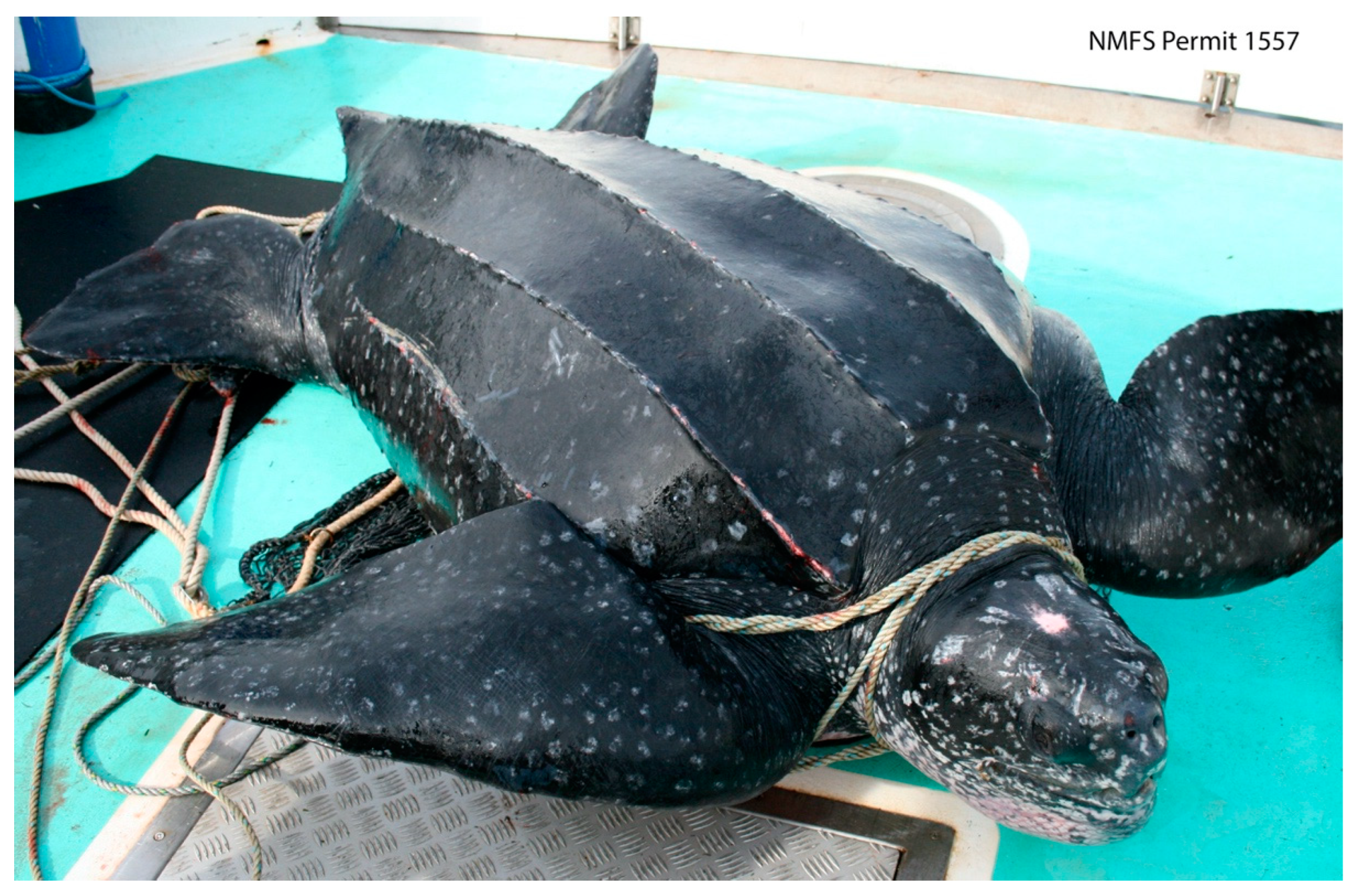
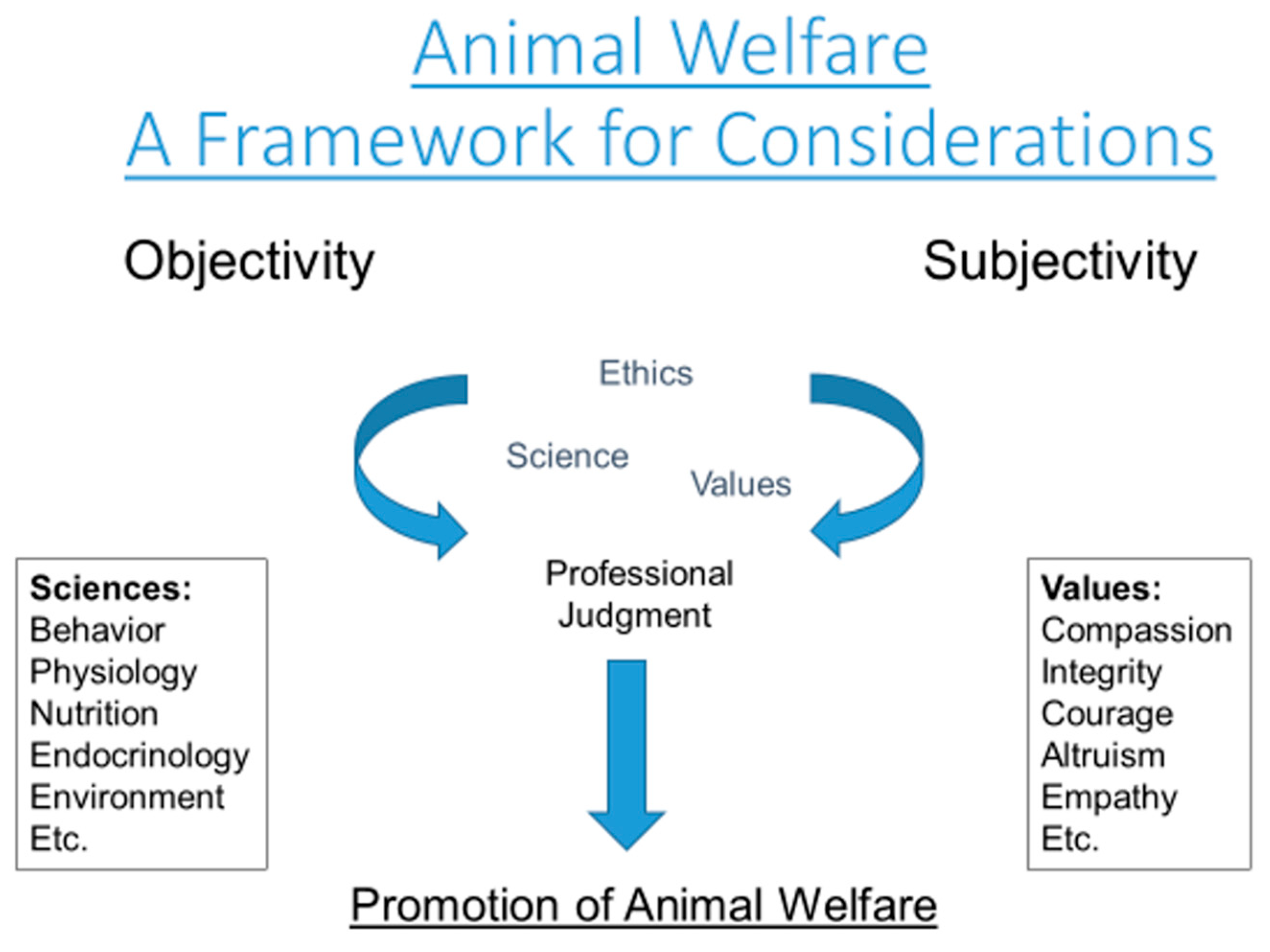
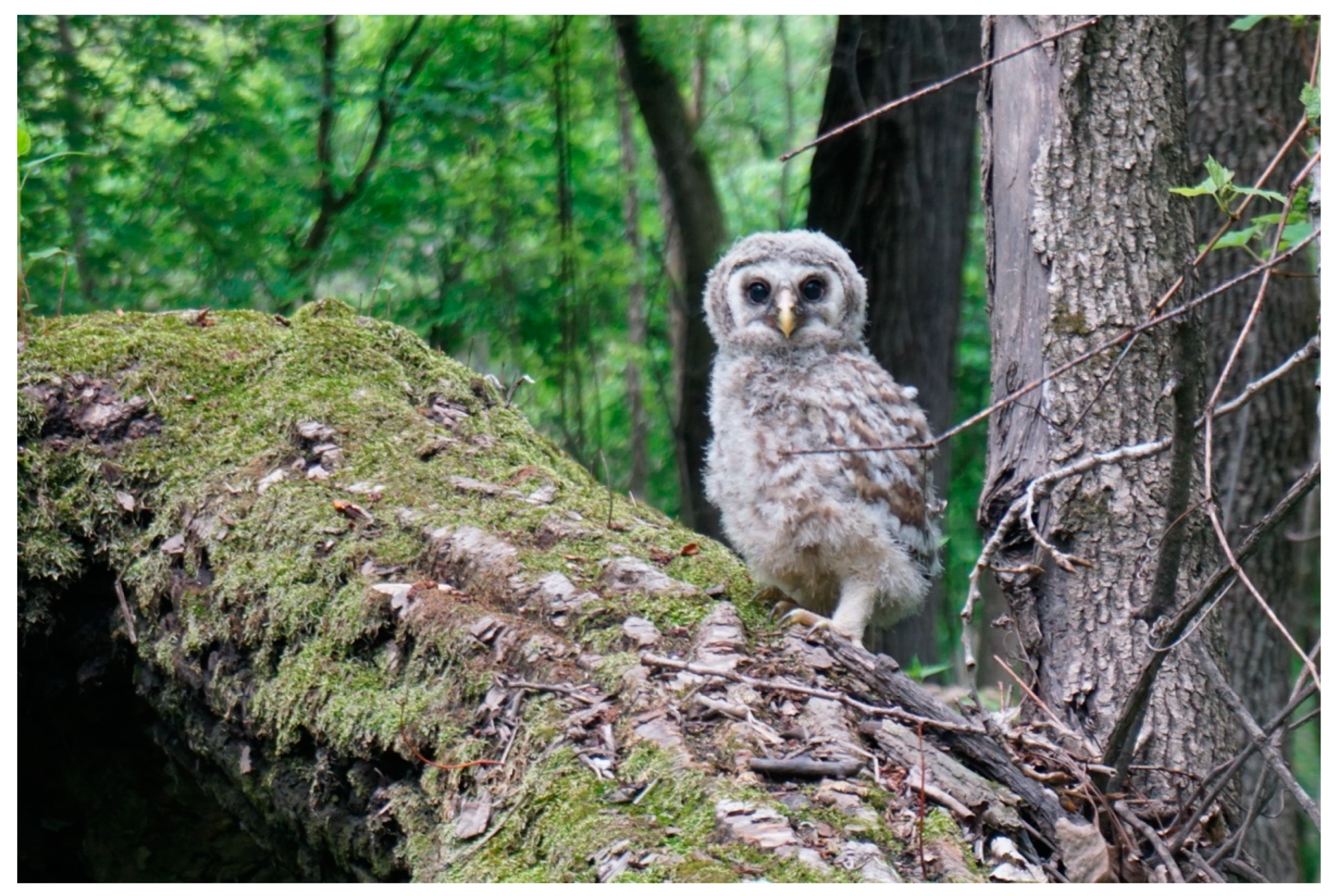
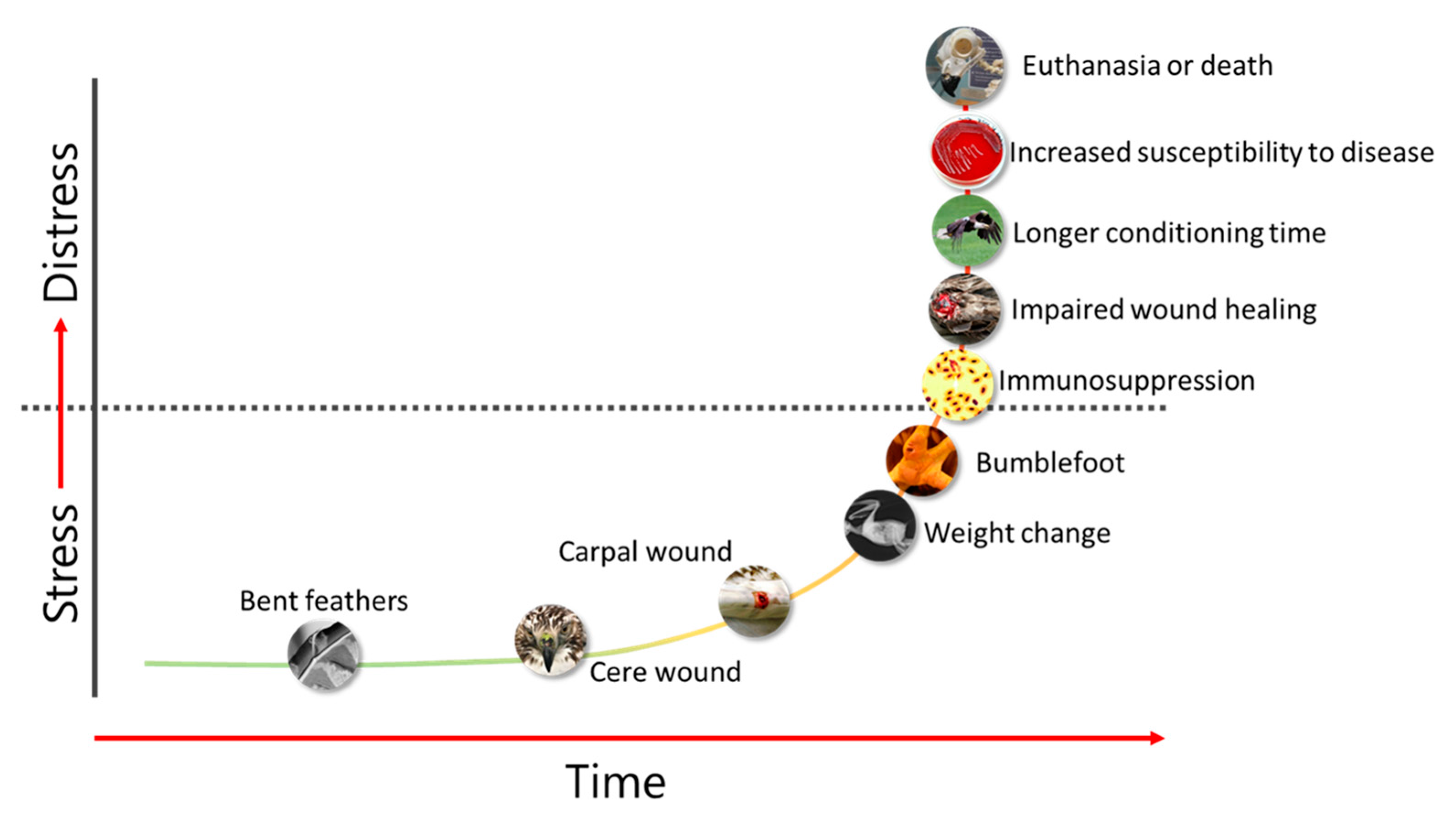
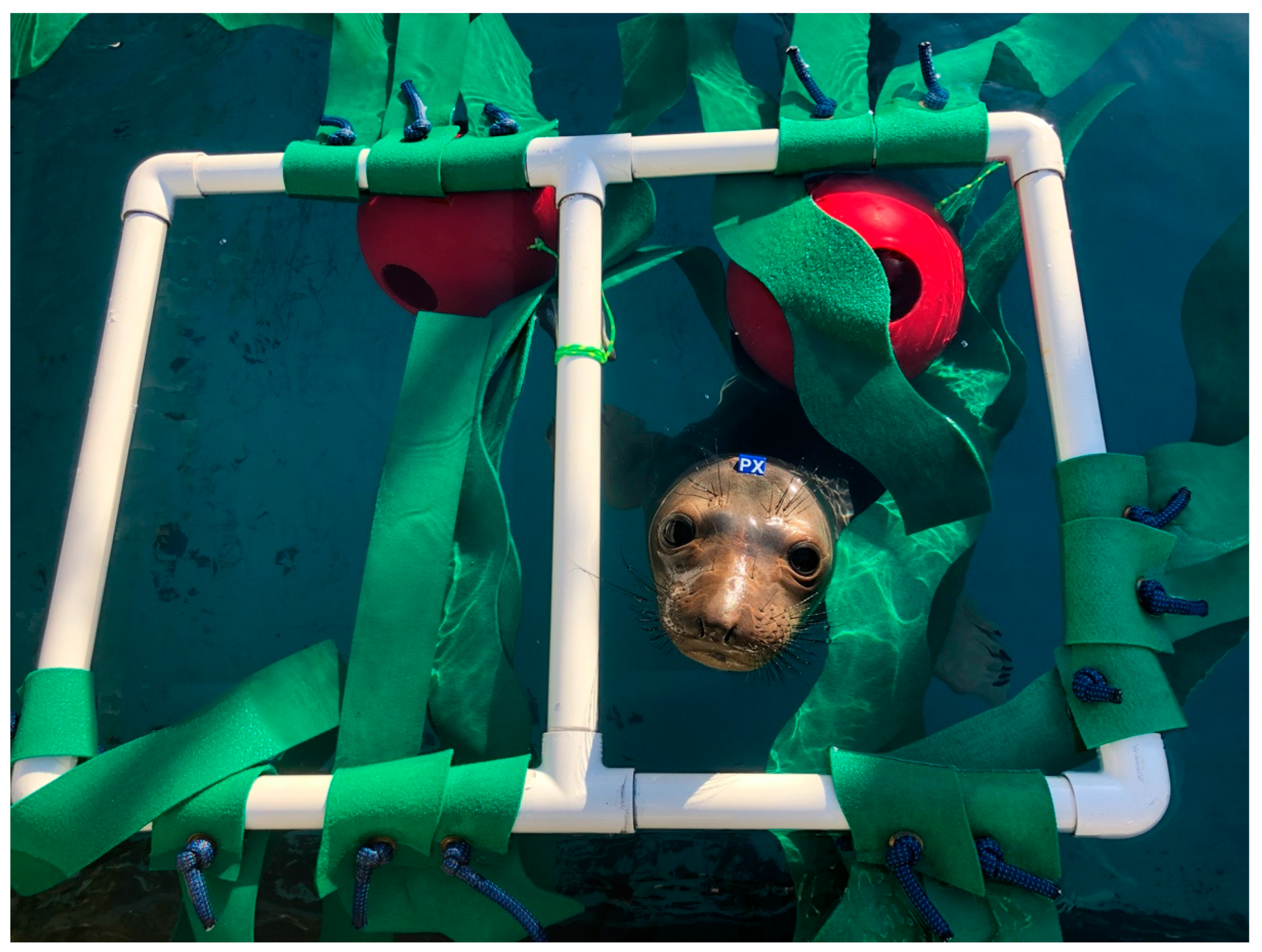
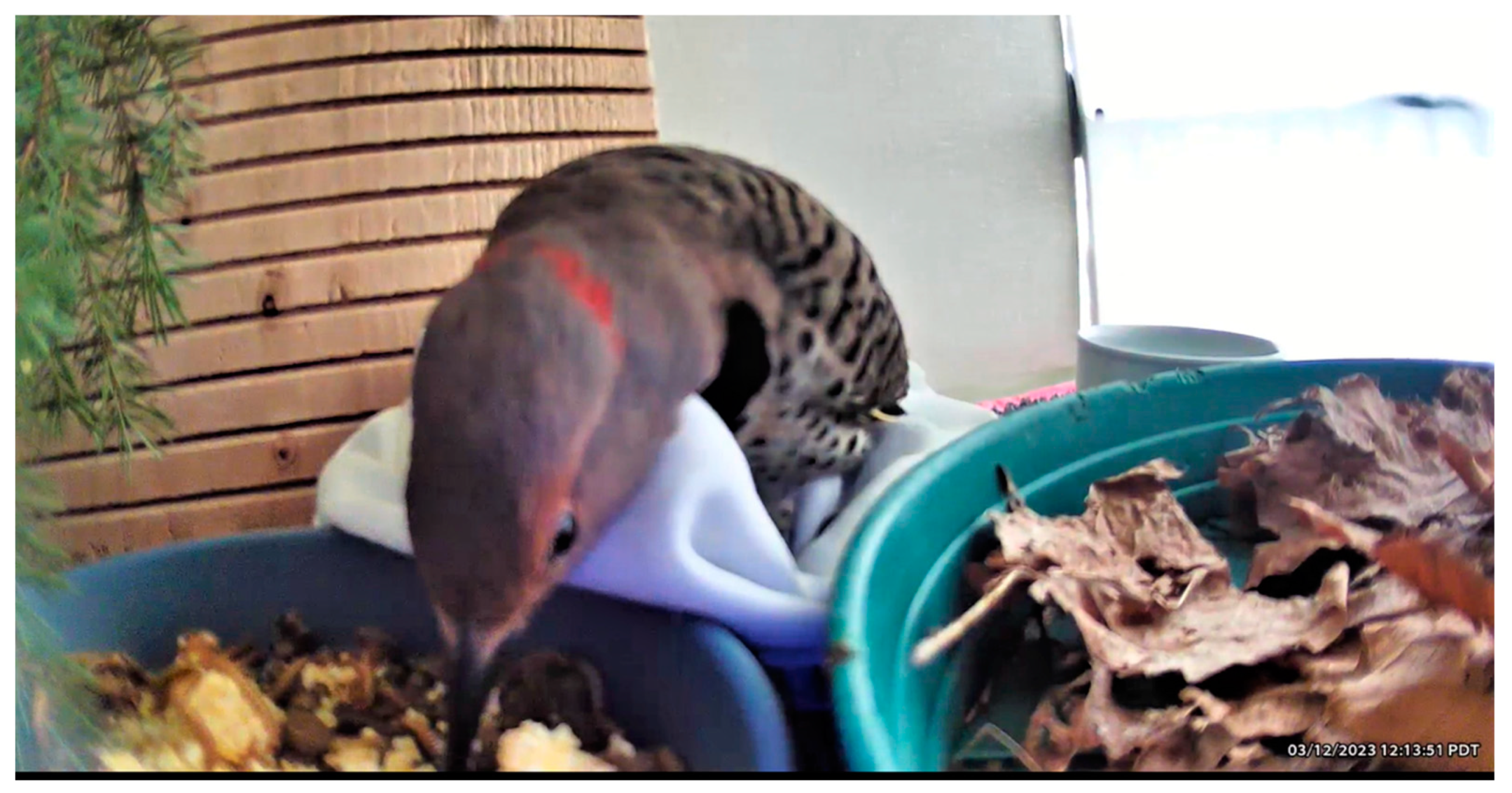
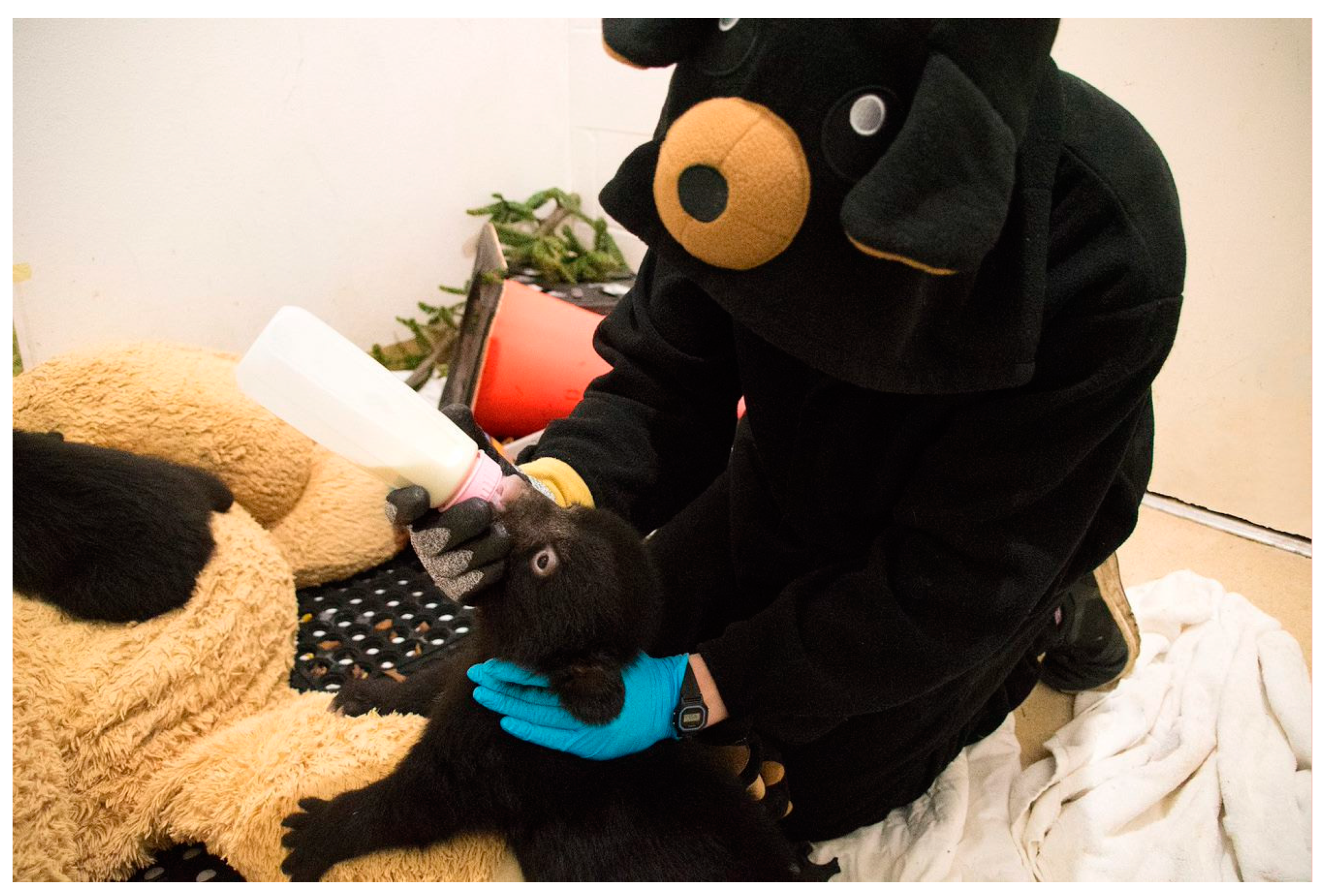
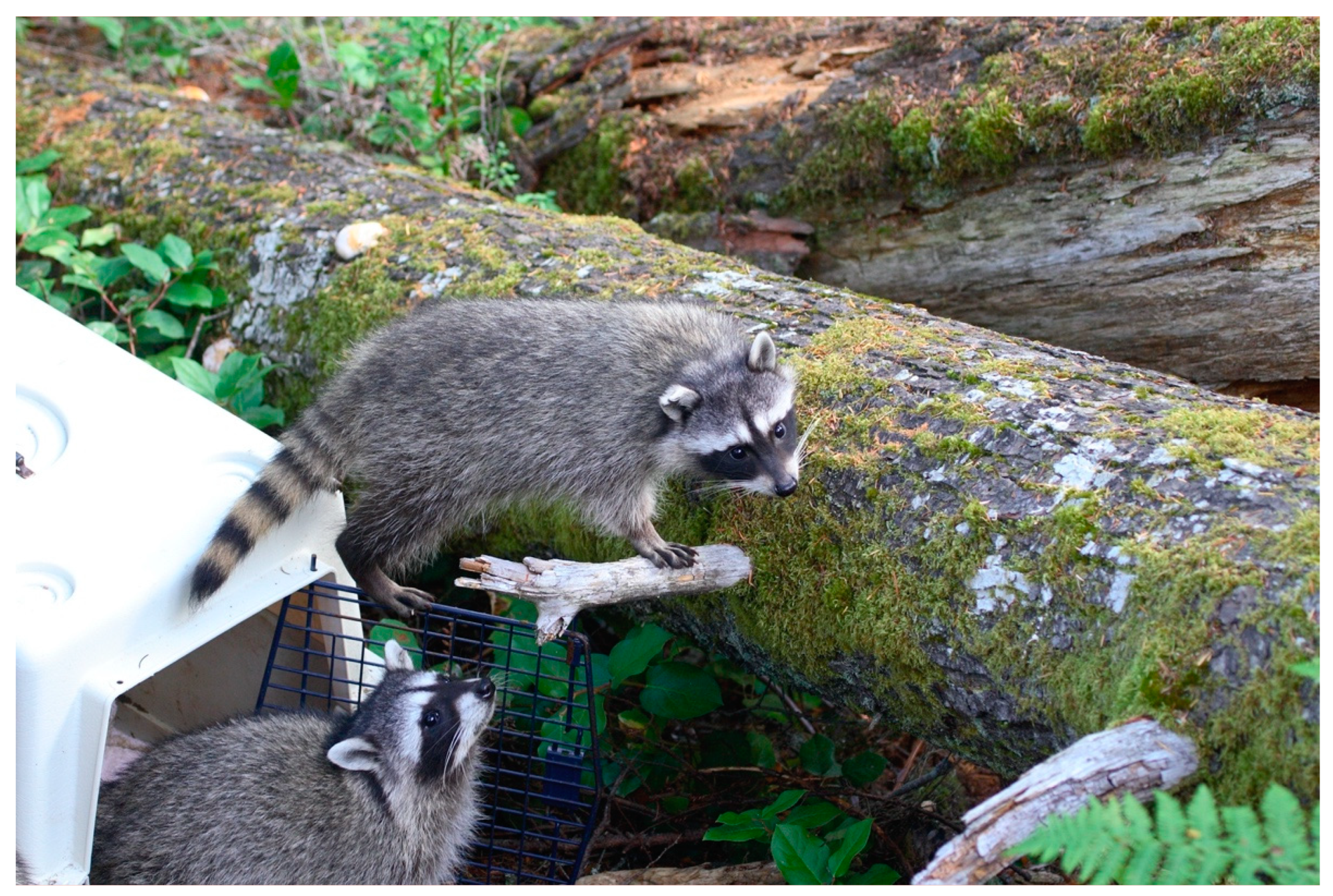
| Criteria | Euthanasia | Release | Captive Placement |
|---|---|---|---|
| Mission | Rare; if release fails, assess physical, emotional, behavioral, and environmental aspects for placement | ||
| Legal Restrictions | |||
| Federal | Appropriate federal MBTA Permit—Rehabilitation MBTA—any bird that cannot feed itself, perch upright, or ambulate without inflicting additional injuries to itself where medical and/or rehabilitative care will not reverse such conditions; any bird that is completely blind; and any bird that has sustained injuries that would require amputation of a leg, a foot, or a wing at the elbow or above (humeroulnar joint) MBTA—obtain authorization before euthanizing endangered and threatened migratory bird species… without USFWS authorization when prompt euthanasia is warranted by humane consideration for the welfare of the bird. | Appropriate federal MBTA Permit—Rehabilitation | MBTA Permit—Veterinarian Statement of Condition that Renders Migratory Bird/Eagle as Non-Releasable MBTA Permit—Special Purpose—Possession for Education (Live) BGEPA Permit—Eagle Exhibition |
| Drug Enforcement Agency—Controlled Substances Act | Drug Enforcement Agency—Controlled Substances Act Food and Drug Agency— Federal Food and Drug Cosmetic Act (AMDUCA) | ||
| State | Appropriate state wildlife rehabilitation permit Veterinary Practice Acts Pharmacy Schedule Reportable Diseases List | Appropriate state wildlife rehabilitation permit Veterinary Practice Acts Pharmacy Schedule Reportable Diseases List | Appropriate state wildlife placement permit |
| Assessments | |||
| Physical/Body | Non-repairable bony fractures or soft-tissue injuries Malunion or healed malaligned fracture Joint trauma including fractures/luxations/subluxations Partial wing amputations * >10% decrease in long bone length (except femur) Significant trauma to patagium and/or patagial tendon * Coelomic trauma with exposed/contaminated internal organs “Spinal trauma” with posterior paralysis and/or no “deep pain” response Severe toxicity with clinical signs * Severe starvation * Permanent eye injury (injuries) with vision deficits * Severe pododermatitis (Grade 4/5) Amputation of 1st and/or 2nd digit * “Three Strikes Rule” * | Full recovery from illness and/or injuries with no clinical evidence of complications Goals of physical reconditioning program met with normal flight mechanics, strength, and endurance for species A complete set of healthy remiges and rectrices (natural or imped) No risk to human/domestic animal/wildlife/environmental health and safety | Injuries are completely healed Illness or injury will not progress Permanent injury compatible with captive purpose |
| Emotional/Mind | Prior injury/illness is not painful Adapting well to captivity | ||
| Behavioral/Nature | Exhibits inappropriate behavior due to medical condition Hard “malimprint” or habituated * | Exhibits species-appropriate natural behaviors Able to acquire live prey | Exhibits species-appropriate behavior Injury/illness will not prevent opportunities to thrive (perch, move, balance, self-feed, bathe, and conduct species appropriate behaviors) Does not exhibit self-destructive or stereotypic behaviors Not aggressive towards humans |
| Resources (Required vs Available) | Training as appropriate for method Licensing as appropriate for method (chemical euthanasia) Availability of proposed drug for chemical euthanasia | Resources required for care and/or treatment, including facility/equipment, diet, knowledge, skills Understanding of species biology, natural history, welfare needs and behavior Rehabilitation of this individual will not adversely affect the facility’s operation Availability of nest/foster nest Appropriate release protocol Identification and post-release monitoring if possible | Appropriate placement available, including permits, resources, knowledge, training and welfare standards Appropriate acquisition for facility’s collection plan Access to veterinary services Appropriate housing available Environment appropriate to exhibit natural behaviors |
| Professional Standards Best Practices References | AVMA Guidelines for Euthanasia of Animals (Current Edition) NWRA Wildlife Formulary (Current Edition) AVMA Professional Code of Ethics NWRA Professional Code of Ethics | NWRA Minimum Standards for Wildlife Rehabilitation (Current Edition) NWRA Principles of Wildlife Rehabilitation (Current Edition) IWRC Wildlife Rehabilitation—A Comprehensive Approach (Current Edition) | Raptors in Captivity: Guidelines for Care and Management (Current Edition) AZA Institutional Ambassador Animal Policy/Placement Tool Wildlife In Education: A Guide for the Care and Use of Program Animals (Current Edition) GFAS Standards for Birds of Prey Sanctuaries (Current Edition) NWRA Professional Code of Ethics—Educators |
| Means to Reduce Stress—Practice Controls | Means to Reduce Stress—Administrative Controls |
|---|---|
| Proximity to humans | |
| Use peripheral vision/avoid direct eye contact Provide visual barriers Provide species-appropriate ambient sound Provide hides/retreat spaces Avoid placing enclosures in high-traffic areas Reduce time in captivity when it no longer benefits the patient Set rules for media interaction | Foster a work culture that is focused on stress reduction and patient advocacy Be mindful of the experience the patient is having at all times Educate all staff, volunteers, and visitors about stress and stress-reduction practices Develop written policies about talking, answering phones, or otherwise attempting to multitask while caring for patients Develop written media guidelines for rescue or release Have policies in place regarding appropriate behavior around patients |
| Restricted movement/Reduced retreat space | |
| Offer complex enriched environments; Offer opportunities for exploration Mimic natural surroundings and substrates Provide hides/retreat spaces if space allows Provide visual barriers on the enclosure in lieu of retreat space Reduce captive auditory stressors | Develop an enrichment plan that includes elements related to all senses Develop a matrix that identifies enrichment opportunities for patients at different activity levels or rehabilitation phases |
| Foreign environment and loss of control/decision-making capacity | |
| Use natural history to inform decisions; observe seasonal photoperiod and humidity Use appropriate indoor lighting; avoid use of fluorescent lights Mimic normal thermal environments when possible; mimic natural surroundings and substrates Offer complex enriched environments Provide opportunities for choice (e.g., food items, enrichment items, shelter options) | Assign one person (or a team of volunteers) to create enrichment opportunities for in-house patients on a weekly basis Develop an enrichment calendar so that types of enrichment offered are rotated on a regular basis Design larger enclosures with areas of different temperatures, humidity, light, hides, or other options, to diversify choices |
| Visual, auditory, and olfactory stressors | |
| Avoid direct eye contact and sudden movements Refrain from wearing jewelry, bold patterns, or bright colors Be mindful of light intensity and light selection; avoid use of fluorescent lights Use cage covers that let light through while still providing visual barrier when appropriate Be aware of sounds from routine tasks, and try to mitigate them Use white-noise machines or appropriate nature recordings to mask unnatural sounds (e.g., use recordings of ocean sounds for seabirds and shorebirds) Use natural colors within the facility (e.g., walls, floors, artwork, uniforms, sheets/towels) Use unscented cleaning products whenever possible; refrain from using perfumes or scented lotions Do not smoke or use car air fresheners in transport vehicles Avoid placing enclosures in high-traffic areas | Create a culture where consideration of patient’s audio experience is prioritized Develop written dress code policy Develop written policies to reduce unnecessary “peeking” into enclosures by staff and volunteers Develop written policies to reduce speaking in clinic or rehabilitation center, or with patients in hand Model behavior for others Design interior spaces to take advantage of natural light sources |
| Capture, handling, and restraint | |
| Use passive capture techniques that do not require handling, and limit chase Use experienced personnel for difficult captures Allow new patients to rest and recover from capture, handling, and transport stress prior to performing exams unless immediate life-saving treatment is required Use firm but gentle restraint Keep patient’s head covered unless it is being examined Have tools and supplies necessary for treatment to reduce time in hand Have a handler for exams/treatments when appropriate Limit readjustments and movement of the animal on the exam table (e.g., the examiner can move when possible rather than move the animal) Consider natural history and physical build of the patient to identify ways to increase comfort (e.g., memory foam can be added to exam tables for large-bodied birds to relieve pressure on the keel; mirrors can be used to examine the undersides/bellies of porcupines) Reduce need for capture and handling in the facility by use of remote monitoring Evaluate the necessity of handling and weigh the cost to the benefit of treatment Use retractable curtains, temporary walls, or other physical barriers to reduce enclosure dimensions during capture | Have written transport policies and protocols for volunteers and staff Design and arrange enclosure furnishings to ease capture Design new enclosures to ease capture (e.g., built-in capture chutes, dens with doors that can be closed remotely, hospital cages with dividers) Know the goals for each exam or treatment |
| Pain | |
| Provide appropriate substrates and padding as needed; medically manage pain Euthanize non-treatable animals as soon as possible to prevent further suffering | Stay current on pain management protocols and support therapies Develop written euthanasia guidelines and protocols specific to the species in rehabilitation and the resources available at the facility Network and consult with other rehabilitators on difficult decisions, particularly rehabilitators with species’ expertise |
| Proximity to nonhuman predators | |
| Provide visual and auditory barriers House predator and prey species in separate areas House predators out of visual and hearing range of prey species | Map out enclosures with species designations Consider predator/prey proximity when designing enclosures |
| Disturbance (peeking, observations, cage cleaning, feeding) | |
| Establish routines; bundle tasks; reduce disturbance Prohibit or restrict visitors Move slowly; avoid direct eye contact Use remote cameras, baby monitors, or ceiling-mounted mirrors to observe behavior without handling | Have a written policy regarding visitors and public access Patients should not be able to see members of the public at any time (see USFWS 50 CFR 21.71) |
| Maintenance in abnormal social groups | |
| House with conspecifics Provide foster parent when appropriate; reduce the number of individuals per enclosure Do not transport or house wildlife patients with domestic animals | Develop a policy for transferring single juvenile animals to a facility with conspecifics (and form a network to facilitate transfers) Have a written policy for a number of animals to be housed in each enclosure Have a written policy establishing limits on intake of number of individuals per species |
| Reduced feeding opportunities | |
| Offer complex feeding challenges (e.g., food hidden in environment, food inside objects) Use native plants when possible Use techniques to provide natural live foods, such as fruit bins to attract edible insects (e.g., fruit flies) Place food in a location where animals feel comfortable feeding (e.g., away from entrance) | Develop an enrichment plan that includes elements related to all senses Develop a matrix that identifies enrichment opportunities for patients at different activity levels or rehabilitation phases |
| Diet change | |
| Use native plants and seasonal/natural food sources when appropriate Use natural history to inform methods of food presentation Identify tricks for encouraging difficult eaters in captivity; leave enough food of multiple varieties in enclosures | Network with species specialists about best foods, tricks and techniques Calculate metabolic requirements and deficits to determine the amount to be fed Develop a network to gather natural foods (e.g., local fishermen, gardeners, naturalists to collect insects) |
Disclaimer/Publisher’s Note: The statements, opinions and data contained in all publications are solely those of the individual author(s) and contributor(s) and not of MDPI and/or the editor(s). MDPI and/or the editor(s) disclaim responsibility for any injury to people or property resulting from any ideas, methods, instructions or products referred to in the content. |
© 2023 by the authors. Licensee MDPI, Basel, Switzerland. This article is an open access article distributed under the terms and conditions of the Creative Commons Attribution (CC BY) license (https://creativecommons.org/licenses/by/4.0/).
Share and Cite
Willette, M.; Rosenhagen, N.; Buhl, G.; Innis, C.; Boehm, J. Interrupted Lives: Welfare Considerations in Wildlife Rehabilitation. Animals 2023, 13, 1836. https://doi.org/10.3390/ani13111836
Willette M, Rosenhagen N, Buhl G, Innis C, Boehm J. Interrupted Lives: Welfare Considerations in Wildlife Rehabilitation. Animals. 2023; 13(11):1836. https://doi.org/10.3390/ani13111836
Chicago/Turabian StyleWillette, Michelle, Nicki Rosenhagen, Gail Buhl, Charles Innis, and Jeff Boehm. 2023. "Interrupted Lives: Welfare Considerations in Wildlife Rehabilitation" Animals 13, no. 11: 1836. https://doi.org/10.3390/ani13111836
APA StyleWillette, M., Rosenhagen, N., Buhl, G., Innis, C., & Boehm, J. (2023). Interrupted Lives: Welfare Considerations in Wildlife Rehabilitation. Animals, 13(11), 1836. https://doi.org/10.3390/ani13111836






